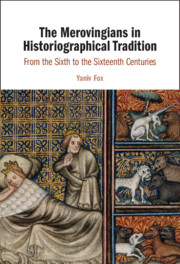Book contents
- The Merovingians in Historiographical Tradition
- The Merovingians in Historiographical Tradition
- Copyright page
- Contents
- Acknowledgements
- Abbreviations
- Introduction
- Part I Lions and Unicorns
- Part II Bears and Wolves
- Chapter 3 Taedit me memorare: The Middle Merovingians
- Chapter 4 Omni ecclesiastica dignitate nobilitavit: “Good King Dagobert”
- Part III Dogs and Lesser Beasts
- Bibliography
- Index
Chapter 4 - Omni ecclesiastica dignitate nobilitavit: “Good King Dagobert”
from Part II - Bears and Wolves
Published online by Cambridge University Press: 02 November 2023
- The Merovingians in Historiographical Tradition
- The Merovingians in Historiographical Tradition
- Copyright page
- Contents
- Acknowledgements
- Abbreviations
- Introduction
- Part I Lions and Unicorns
- Part II Bears and Wolves
- Chapter 3 Taedit me memorare: The Middle Merovingians
- Chapter 4 Omni ecclesiastica dignitate nobilitavit: “Good King Dagobert”
- Part III Dogs and Lesser Beasts
- Bibliography
- Index
Summary
Of all the Merovingian kings who came after Clovis, none has received more accolades than Dagobert I, considered to have been the last effective Merovingian, succeeded by increasingly less capable kings until the dynasty’s demise. Dagobert as a literary convention nevertheless had to be constructed, a process that began in the Chronicle of Fredegar. Fredegar’s portrayal is favorable up to a point, beyond which the chronicler singled out the king for reproof. The idealization of Dagobert reached new heights with the ninth-century Gesta Dagoberti I regis Francorum, which accentuated the king’s monastic patronage, particularly regarding Saint-Denis, where the composition was penned. In the early tenth century, Regino of Prüm used the Gesta Dagoberti to narrate the life ofDagobert in his Chronicle. The character Regino extracted from the Gesta Dagoberti was remolded to serve different aims. This chapter follows the story as it was related in Fredegar and the transformations it underwent in the Gesta Dagoberti. It then turns to the adaptation of the hagiographically inflected Dagobert narrative back into historiography in the tenth-century Chronicle of Regino of Prüm.
- Type
- Chapter
- Information
- The Merovingians in Historiographical TraditionFrom the Sixth to the Sixteenth Centuries, pp. 170 - 222Publisher: Cambridge University PressPrint publication year: 2023



